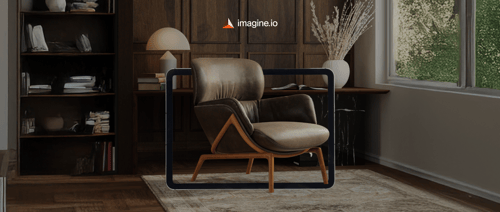In a world where user experience is everything, your Shopify store can’t afford to lag—literally or figuratively.
You want your customers to have a seamless, interactive shopping experience. Maybe you're selling configurable furniture, mattresses, or home appliances. Whatever the product, shoppers now expect to customize what they buy—color, size, material, finish—and get real-time visuals as they do it.
That’s where a product configurator comes in. But if you’re part of the website team at a mid-market or enterprise brand, you’ve likely asked yourself:
- Will this slow down our site?
- Will it mess with our frontend performance?
- Can it coexist with our Shopify stack and styling standards?
These are all valid concerns. Let’s walk through how to add a product configurator to Shopify without compromising performance—and how modern tools like imagine.io make it possible to deploy without disruption.
Get the latest updates straight to your inbox.
By clicking sign up you'll receive occasional emails from imagine.io. You always have the choice to unsubscribe within every email you receive.
First, Why Use a Product Configurator?
A product configurator isn't just a visual gimmick. For many categories, it's becoming table stakes. Here's why:
- Increased conversion: Shoppers are more likely to buy when they can see and build exactly what they want.
- Lower returns: When customers know what they’re getting, they’re less likely to send it back.
- Higher AOV: Customization often encourages upsells and add-ons.
But of course, these benefits mean nothing if the configurator drags down your site's performance.
Shopify + 3D Configurators: The Challenge
Shopify is built for speed and simplicity, and its theme architecture is optimized for fast page loads and tight integration with apps. However, third-party visual tools—especially online 3D product configurator software — can create potential bottlenecks:
- Page load bloat from large scripts or unoptimized media
- Frontend conflicts due to tightly coupled DOM elements or inline styling
- Breaks in SEO if the tool interferes with crawlable content
- Platform mismatch if the online product configurator doesn’t play well with Liquid, Shopify's templating language
That’s why integration needs to be smart, modular, and flexible.
What to Look for in a Performance-Friendly Configurator Tool
If your job is to maintain web performance, UX consistency, and stack integrity, here are five must-haves:
-
Lazy Loading
Ensure the product configurator tool loads only when needed—not on the initial page load. This preserves LCP (Largest Contentful Paint) scores and improves perceived speed.
Pro Tip: Look for tools that support deferred script loading and conditional rendering based on viewport or interaction.
-
CDN-Backed Assets
A reliable content delivery network (CDN) means faster asset delivery across regions. This is especially important if your user base is global.
Why it matters: If your 3D product configurator models are hosted on slow servers or heavy cloud platforms without edge optimization, expect poor Time to Interactive (TTI).
-
Headless and API-Ready
You want maximum flexibility. 3D product configurators with APIs let your developers integrate it cleanly with Shopify Hydrogen or existing headless setups—without breaking your component structure. imagine.io, for instance, gives developers sandbox environments to test and deploy safely.
-
Full CSS & DOM Control
Styling is sacred to any frontend team. Your product configurator should respect your design system and not introduce inline styles or unscoped classes. Look for tools that support full CSS override, clean DOM architecture, and SCSS compatibility.
-
Core Web Vitals-Friendly
You should be able to monitor and optimize LCP, FID, and CLS with or without the product configurator ecommerce integration. If your CLS (Cumulative Layout Shift) spikes post-integration, that’s a red flag. Some product configurator websites, like imagine.io’s, come optimized for Core Web Vitals out-of-the-box.
Implementation Workflow (Without Disruption)
Here's a roadmap that works well for Shopify-based enterprise brands:
- Isolate on Staging First: Use a sandbox or Shopify staging theme to test configuration loading and styling. Validate network requests and script behavior.
- Lazy Load via Custom Section or App Embed: Implement the Shopify product configurator as a custom Shopify section or embed block with lazy-loading attributes.
- Monitor with Lighthouse & WebPageTest: Benchmark before and after page speed scores to identify regressions. A good 3d product configurator will show negligible impact.
- Use Webhooks or Shopify Functions for Variant Syncing: Connect the output of the product configurator to Shopify’s product options, cart, or checkout using functions or custom apps.
- QA Across Devices and Browsers: This includes mobile responsiveness, touch gestures, and browser-specific performance handling.
How imagine.io Makes This Easier
Let’s be honest—adding any new tech to an enterprise Shopify store is never plug-and-play. But imagine.io was built with website teams in mind. It offers:
- Performance-optimized embeds that lazy-load when triggered
- Developer-friendly APIs for headless or traditional Shopify setups
- CDN-hosted 3D product configurator ecommerce models that load fast, globally
- Full control over design and styling so it fits right into your brand's frontend ecosystem
- Integration support for Shopify, BigCommerce, Salesforce, Magento, and more
That means less hand-holding for your engineering team, and more confidence for leadership.
Real-World Use Case: Furniture Brand Scaling Custom Orders
One of our clients—a $200M+ furniture brand—needed a way for customers to customize sofas by fabric, color, legs, and size on Shopify. Their web team was worried about page speed and SEO hits. By integrating imagine.io’s 3D custom product configurator using lazy loading and CDN delivery, they were able to:
- Improve conversion rates by 23%
- Maintain 95+ Lighthouse scores
- Preserve SEO rankings with zero CLS spikes
And it all happened without re-platforming or major theme edits.
Conclusion: Performance and Customization Can Coexist
A product configurator tool can drive higher sales, lower returns, and deeper shopper engagement—but not if it undermines your site’s performance. By choosing a solution that respects Core Web Vitals, supports lazy loading, and gives your dev team API and CSS control, you can elevate your customer experience without compromise.
If you're evaluating 3D configurator product solutions for your Shopify store, and performance is top of mind, it's worth seeing what imagine.io can do. Ready to see it in action? Book a Demo today and explore how seamlessly a visual product configurator can fit into your Shopify experience—without slowing you down.


.gif?width=1296&height=1296&name=Untitled%20design%20(8).gif)



.png?width=500&name=How%20to%20Add%20a%203D%20Product%20Configurator%20to%20Your%20WordPress%20Website%20(Complete%20B2B%20Guide).png)
















%20(1).png?width=500&name=Why%20Exploded%20Mattress%20Views%20Matter%20(And%20How%20to%20Generate%20Them)%20(1).png)
.png?width=500&name=Best%20Shopify%20Product%20Configurator_%20How%20to%20Choose%20the%20Right%20One%20(2).png)
.png?width=500&name=Why%20Exploded%20Mattress%20Views%20Matter%20(And%20How%20to%20Generate%20Them).png)



.png?width=500&name=Best%20Shopify%20Product%20Configurator_%20How%20to%20Choose%20the%20Right%20One%20(1).png)







.png?width=500&name=How%203D%20Rendering%20Can%20Make%20or%20Break%20Your%20Industrial%20Design%20Pitch%20(1).png)








%20with%20Digital%20Twins%20and%203D%20Visualization.png?width=500&name=Optimizing%20Your%20Digital%20Asset%20Management%20(DAM)%20with%20Digital%20Twins%20and%203D%20Visualization.png)




.png?width=500&name=Styling%20Home%20Decor%20for%202025_%20From%20Global%20Influences%20to%20Playful%20Personalization%20(1).png)

